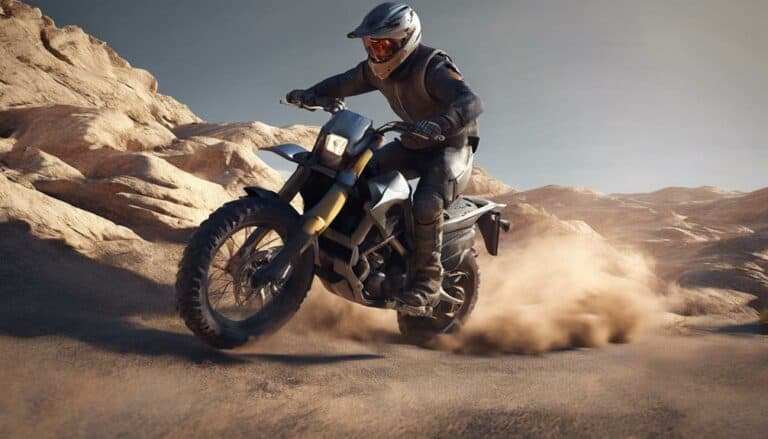When cruising over rough terrain on your bike, have you ever questioned if your body positioning truly affects your ability to sustain momentum and grip the ground?
The relationship between how you position your body and your bike's performance is a critical aspect that can either make or break your ride.
By understanding the intricate connection between body movements and terrain navigation, you can discover the secret to mastering challenging trails and conquering rugged landscapes with ease.
Key Takeaways
- Proper body positioning maximizes traction and control on rugged terrain.
- Effective weight distribution enhances stability and handling.
- Precise body positioning aids in navigating obstacles and maintaining momentum.
- Adjusting body lean angle and weight distribution optimizes traction and stability.
Importance of Body Positioning for Traction
Proper body positioning on rugged terrain is essential for maximizing traction and control while riding. Distributing your weight effectively between the front and rear of the bike can greatly impact the available traction.
When riding, make sure your body is centered on the bike, leaning slightly forward to improve traction at the front wheel. This positioning helps in better handling and stability over challenging surfaces.
Maintaining Momentum on Rugged Terrain
Maintaining momentum on rugged terrain requires precise body positioning to navigate obstacles and optimize forward movement. As a rider, your good body position is essential for keeping control over your bike on challenging surfaces. By shifting your weight properly, you can make sure that your rear wheel maintains traction, preventing unnecessary slips that could hinder your momentum.
When tackling downhill riding, it's important to adjust your body lean angle accordingly, leaning the bike while keeping your weight centered over the tires. This technique not only helps you navigate through rough terrain but also assists in preserving your momentum. Effective weight transfer through your body positioning is key to absorbing impacts and reducing the risk of losing control over your bike.
Remember to maintain an active stance with your knees and elbows bent, allowing you to adapt swiftly to the ever-changing conditions of rugged terrain and keep your forward progress steady.
Correct Body Position for Uphill Challenges
To tackle uphill challenges successfully, position your chest forward to enhance traction and stability while climbing. By shifting your weight forward over the front wheel, you can improve grip and prevent wheel spin on steep inclines. It's important to keep your hands light on the handlebars with dropped wrists to navigate technical uphill sections effectively. Additionally, adjusting your hip position forward in the saddle helps distribute weight efficiently for better traction. Achieving a balanced weight distribution through a combination of forward lean and proper bike setup is essential for maintaining momentum on uphill terrain.
When climbing uphill, focus on a forward chest position and balanced weight distribution to maximize your bike's traction. Make sure your hands are light on the handlebars, your weight is shifted slightly forward, and your hip position is adjusted forward for stability. These techniques will help you conquer challenging uphill sections with confidence and control. Remember, the key to successful uphill riding lies in maintaining a forward-leaning posture and distributing your weight effectively for the best traction.
Enhancing Traction Through Body Placement
When tackling rugged terrain, optimizing traction through precise body placement is key to maintaining control and stability over your bike. By strategically adjusting your body position, you can enhance grip and stability, allowing you to navigate challenging terrain more effectively.
- Center Your Body Mass: Position your body directly over the bike's contact patch to maximize traction and control. This helps distribute your weight evenly between the front and rear wheels, improving stability on uneven surfaces.
- Lean the Bike, Keep Upright: Lean the bike into turns while keeping your body upright. This technique increases grip on rocky terrain by allowing the tires to maintain better contact with the ground.
- Adapt to Terrain Features: Adjust your body position based on the terrain features you encounter. By shifting your weight to maintain the most suitable weight distribution, you can enhance traction, maintain momentum, and prevent sliding on challenging surfaces like rocky terrain.
Body Positioning Strategies for Tough Terrain
Lowering your center of gravity and widening your stance can greatly increase stability when tackling rough terrain on your bike. In challenging situations, adjusting your body positioning is key to maintaining balance and control.
When descending steep and rugged terrain, shifting your weight back and using the rear brake for downhill braking can prevent you from going over the handlebars. To maintain momentum and traction uphill, shift your weight slightly forward to prevent the front wheel from lifting and losing grip.
By keeping your center of gravity low and distributing your weight evenly, you optimize traction and minimize the risk of sliding out. Remember, proper body positioning is essential for traversing rugged terrain effectively.
Adapt your riding positions to the terrain variations to make sure you have the best control over your bike. Mastering these body positioning strategies will enhance your ability to conquer tough terrain with confidence and skill.
Conclusion
As you navigate through rugged terrain, remember that your body positioning is key to maintaining momentum and traction.
Like a skilled dancer effortlessly gliding across the stage, your movements must be precise and intentional to conquer the obstacles in your path.
By mastering the art of weight distribution, center of gravity control, and stance width, you can guarantee a smooth ride and conquer even the toughest trails with confidence.
Practice, adjust, and conquer – the trail awaits your next move.

